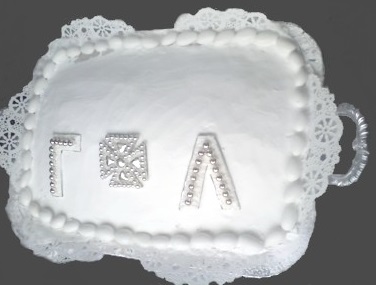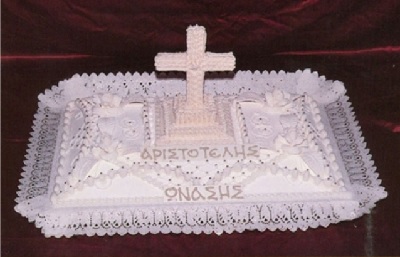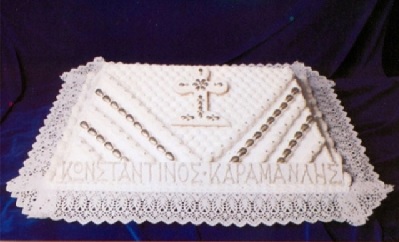 |
|||||||
|
Wheat of Life: Remembering Lost Loved Ones |
|||||||
|
As a youngster I came to expect the white mounded “cakes” prepared for memorials of departed loved ones whenever an older member of the local Greek community passed away. These cakes were delicious, filled with blonde raisins, slivered almonds, boiled wheat berries, and spices, topped off with a layer of white powdered sugar. At the end of Sunday church services, the tray of “kollyva” blessed by the parish priest would be removed and the contents of the white mound divided up into small paper cups or plastic bags for departing parishioners. It was one of my favorites. Occasionally, to my great delight, I would discover one or two pomegranate seeds or silver dragees included in my small portion. |
|
||||||
|
“Easy Koliva” on pages 230-231 of Popular Greek Recipes by the Charleston, South Carolina Ladies Philoptochos Society furnished me with a base recipe. Another fine recipe can be found in the Guide to Greek Customs and Traditions in America, 2nd edition, by Marilyn Rouvelas, 2002. Slight variations abound, with nearly every family and community following their own specific version. Ingredients The ingredients list for the Charleston recipe is as follows, with my own annotations and modifications noted:
To this list I added
Directions Purchasing wheat berries Preparation of the kollyva begins with the acquisition of several key ingredients, the whole wheat and the zwiebacks. These are not always readily available, depending on one’s locale. Wheat bulgur is NOT a substitute for whole wheat berries. I know. I tried it and realized my mistake at once, returning to the natural foods store to purchase whole wheat berries afterward. Common wheat, Triticum aestivum, is the wheat needed for this. Preparation of zwiebacks Zwiebacks, once a household staple and sold at every supermarket, are no longer widely available. They can be made, with recipes readily available in every Greek community and in Rouvelas’s fine guidebook. I opted to purchase Old London All Natural Melba Toasts, the Classic version, which worked well with my recipe. One 5-ounce box has 5 individually-wrapped packages of 5 small slices, each measuring about 2” x 4”. To make the needed 1 cup of ground zwieback, I placed 4 packages of these toasts into a large, zip-lock plastic bag, sealed it and crushed them completely with a rolling pin. The final sizes of the pieces were no larger than the size of sea-salt grains. To facilitate the crushing, I periodically shook the bag and pounded it with the roller, too. Washing and soaking wheat berries Sort and rinse the wheat berries thoroughly in water. Some sources recommend rinsing with cold water, others with warm water, but the water temperature doesn’t appear to matter. Place the rinsed berries into a large bowl with cold water, cover them, and soak them overnight. Experts seem to agree on the ratio of berries to water in the soaking process: 2.5 cups berries to 5.25 cups water. Adjust your portions, if necessary, but try to preserve the berry-to-water ratio. Note: the Ladies’ cookbook omits the overnight soak step and instead directs to drain and place in a deep saucepan, covering with water and then bringing to a boil and simmering for 3 hours with frequent stirring. Preparing the dry ingredients While waiting for the berries to soak, cook or to dry, combine the finely chopped walnuts, blond raisins, cinnamon, cloves, and granulated sugar and set aside. Do not add the crushed zwieback in this step. Preparing the serving tray Line a serving tray with paper doilies, extending slightly beyond the rim. Cover with plastic wrap. Note: be sure to bring small plastic bags and plastic spoons to the service for distributing the kollyva. Boiling and draining the berries The next day, I rinsed the berries again and added enough water to preserve the berry-to-water ratio. I placed all in a large saucepan and brought it to a boil, then reduced the temperature to low for 3 hours, stirring regularly to prevent the bottom layer of berries from scorching. After 3 hours, drain, rinse in cold water (to stop the cooking process) and dry. See directions below for drying. Drying the berries Several different methods of drying the berries have been used. The South Carolina recipe calls for leaving the wheat in a colander, uncovered overnight. I opted to spread two layers of absorbent paper towels over my dining room table and to lay out the cooked berries spread thinly over the paper towels. Several hours later, the berries were completely dry. Rouvelas indicates that a candle can be lit beside the wheat as it dries. Combining the mixtures After the berries are dry, on the day of the memorial, combine them with the dry ingredients—except the zwieback. Ideally, a censer and candle should both be lit while assembling the mixture and forming the mound of the kollyva (Rouvelas 2002). Form a small cross in the center of the prepared serving tray with the wheat mixture. Then carefully add the remaining amount of mixture, mounding it up into the traditional “hill” shape. Take a large sheet of waxed paper and then press the mixture together and down onto the tray, reshaping into a mound as needed. When the mound is compact, carefully spread the crushed zwieback evenly over the entire mound to keep the mixture separated from the powdered sugar that will form the final finishing layer and to keep it from seeping through the sugar topping. Finishing the Kollyva Mound After compacting the mound, cover evenly with the powdered sugar, smoothing it down with the bowl of a spoon. I found that using another fresh sheet of waxed paper, onto which I gently rubbed the bowl of the spoon gave the best overall final appearance of the “cake.” Make the sign of the cross near the top with the Jordan almonds and the initials of the departed loved one: first initial of the baptismal name on the left and the first initial of the surname on the right. If you have store-bought crosses or letters and other traditional Greek embellishments for the kollyva, go ahead and carefully arrange them on the cake. For mine, I had bought Royal frosting Greek initials and Byzantine crosses made out of silver dragees which I placed on my father’s kollyva; for my mother, I used a daintier cross and some small floral elements, along with a border of the white candied almonds. Most directions suggest leaving a space at the center top for a candle that will be inserted and lit during the service. Yield: 50-60 servings Note: The Ladies Philoptochos recipe indicates that the prepared wheat mixture can be frozen without the powdered sugar. Purchasing Traditional Decorative Crosses and Other Elements Some of the items are available at local kitchen supply stores, such as the almonds and round dragees. But for more elaborate crosses and letters, one can buy them in Greece and bring them back to the United States. That’s what I did. I had undertaken a mission in the months after my mother’s death to search out a supply store in Athens. In the end, I purchased letters, crosses and florets from several stores. I ordered initials and a simple cross from one of the best bakeries for kollyva in Athens: Papios, Anapavseos 27, Plateia A’ Koimitiriou. These were about 5 Euros apiece, and beautifully crafted, each one. The letters begin as sturdy cardboard Greek letters, then are covered with a thin layer of frosting, presumably a Royal frosting recipe. They are then lined on top with silver baking dragees, round or oval, and sometimes with other decorative frosting elements. Individual letters were about 2 x 3 inches each. The store offered crosses, too, of every style imaginable, from types that lay flat on the kollyva, to elaborately wrought ones that stood upright on the “cake.” For those with more complex tastes, there were also small churches and other related decorations that could adorn the cakes. This store, located across from the country’s top cemetery, the First Cemetery, usually caters to up-scale customers.
On another shopping foray into the heart of the city, I discovered another shop with reasonable prices for kollyva decorations and related memorial service supplies on busy Athinas Avenue not far from the Monastiraki subway station. It was fascinating to see the range of flowers, letters, crosses and other items for purchase. This store also carried small paper bags with crosses on the front for dispensing the wheat mixture. Here I also bought —several more crosses, Byzantine style, made in the same fashion as the Greek initials, with a thin layer of frosting onto which dragees were arranged artfully, and about a dozen small pastry florets with round dragee centers. The wait staff was helpful and kind, offering directions on preserving the materials until their use.
|
|||||||
|
Preserving and Using Store-bought Kollyva Decorations |
 Decorations for kollyva purchased in Athens |
||||||
Repairing Bought Kollyva Decorations One or two of my Greek store-bought decorative letters were missing a couple of dragees after some months in my kitchen cupboards. A quick inspection of the box showed that they had simply fallen off and rolled into the corners. Repairing them was a simple matter. I mixed up some powdered sugar icing and piped tiny dots onto the spots where the dragees originally sat. Then I simply replaced the dragees and reused the letters. May their memories be eternal! |
|||||||
|
(Posting date 17 March 2014) HCS encourages readers to view other articles and releases in our permanent, extensive archives at the URL http://www.helleniccomserve.com/contents.html. |
|||||||
|
|||||||
|
2000 © Hellenic Communication Service, L.L.C. All Rights Reserved.
http://www.HellenicComServe.com |
|||||||



